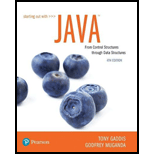
Concept explainers
Arraylist:
It is a collection framework and the java package “java.util.package” is used for this. Arraylist is a dynamic list which is used to store dynamic array elements.
To use Arraylist class in a Java program, it must be imported first from the Java library files.
The statement which must be imported in order to use Arraylist class is,
import java.util.Arraylist;
Syntax for Arraylist:
ArrayList() object_name=new ArrayList();
Here,
- “ArrayList()” is the class name with no arguments. The programmer can use “ArrayList(Collection c)” and “ArrayList(int)” from “util” package.
- “object_name” describes name of the object of Arraylist.
Creation of string ArrayList:
ArrayList <String> x = new ArrayList<String>();
The above statement is an example of creation of ArrayList class. The array object “x” is used to store the list of objects.
Inserting an item at specific location in an ArrayList object:
The items can be inserted at the specified index in an Arraylist object using “add()” method,
Insertion of object at the beginning of the list is as follows:
a.add (0, object);
The “a” is an array list object and “add” is a built-in function which is used to add the objects to the list. The argument “(0, object)” means add the object at the beginning of the object.
Example:
To insert an item at index 2 for ArrayList named List which stores strings, the following statement is used,
List.add(2, “John”);
Want to see the full answer?
Check out a sample textbook solution
Chapter 7 Solutions
EBK STARTING OUT W/JAVA:...DATA...
- Please solve and answer the questions correctly please. Thank you!!arrow_forwardConsidering the TM example of binary sum ( see attached)do the step-by-step of execution for the binary numbers 1101 and 11. Feel free to use the Formal Language Editor Tool to execute it; Write it down the current state of the tape (including the head position) and indicate the current state of the TM at each step.arrow_forwardI need help on inculding additonal code where I can can do the opposite code of MatLab, where the function of t that I enter becomes the result of F(t), in other words, turning the time-domain f(t) into the frequency-domain function F(s):arrow_forward
 EBK JAVA PROGRAMMINGComputer ScienceISBN:9781337671385Author:FARRELLPublisher:CENGAGE LEARNING - CONSIGNMENTProgramming Logic & Design ComprehensiveComputer ScienceISBN:9781337669405Author:FARRELLPublisher:Cengage
EBK JAVA PROGRAMMINGComputer ScienceISBN:9781337671385Author:FARRELLPublisher:CENGAGE LEARNING - CONSIGNMENTProgramming Logic & Design ComprehensiveComputer ScienceISBN:9781337669405Author:FARRELLPublisher:Cengage Programming with Microsoft Visual Basic 2017Computer ScienceISBN:9781337102124Author:Diane ZakPublisher:Cengage Learning
Programming with Microsoft Visual Basic 2017Computer ScienceISBN:9781337102124Author:Diane ZakPublisher:Cengage Learning Microsoft Visual C#Computer ScienceISBN:9781337102100Author:Joyce, Farrell.Publisher:Cengage Learning,
Microsoft Visual C#Computer ScienceISBN:9781337102100Author:Joyce, Farrell.Publisher:Cengage Learning, EBK JAVA PROGRAMMINGComputer ScienceISBN:9781305480537Author:FARRELLPublisher:CENGAGE LEARNING - CONSIGNMENT
EBK JAVA PROGRAMMINGComputer ScienceISBN:9781305480537Author:FARRELLPublisher:CENGAGE LEARNING - CONSIGNMENT C++ Programming: From Problem Analysis to Program...Computer ScienceISBN:9781337102087Author:D. S. MalikPublisher:Cengage Learning
C++ Programming: From Problem Analysis to Program...Computer ScienceISBN:9781337102087Author:D. S. MalikPublisher:Cengage Learning





